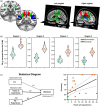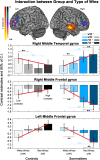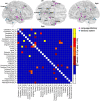Sniffing out meaning: Chemosensory and semantic neural network changes in sommeliers
- PMID: 38339911
- PMCID: PMC10823763
- DOI: 10.1002/hbm.26564
Sniffing out meaning: Chemosensory and semantic neural network changes in sommeliers
Abstract
Wine tasting is a very complex process that integrates a combination of sensation, language, and memory. Taste and smell provide perceptual information that, together with the semantic narrative that converts flavor into words, seem to be processed differently between sommeliers and naïve wine consumers. We investigate whether sommeliers' wine experience shapes only chemosensory processing, as has been previously demonstrated, or if it also modulates the way in which the taste and olfactory circuits interact with the semantic network. Combining diffusion-weighted images and fMRI (activation and connectivity) we investigated whether brain response to tasting wine differs between sommeliers and nonexperts (1) in the sensory neural circuits representing flavor and/or (2) in the neural circuits for language and memory. We demonstrate that training in wine tasting shapes the microstructure of the left and right superior longitudinal fasciculus. Using mediation analysis, we showed that the experience modulates the relationship between fractional anisotropy and behavior: the higher the fractional anisotropy the higher the capacity to recognize wine complexity. In addition, we found functional differences between sommeliers and naïve consumers affecting the flavor sensory circuit, but also regions involved in semantic operations. The former reflects a capacity for differential sensory processing, while the latter reflects sommeliers' ability to attend to relevant sensory inputs and translate them into complex verbal descriptions. The enhanced synchronization between these apparently independent circuits suggests that sommeliers integrated these descriptions with previous semantic knowledge to optimize their capacity to distinguish between subtle differences in the qualitative character of the wine.
Keywords: connectivity; fMRI; flavor; language network; sommelier; taste; wine.
© 2024 The Authors. Human Brain Mapping published by Wiley Periodicals LLC.
Conflict of interest statement
The authors declare no competing interests.
Figures







Similar articles
-
The appreciation of wine by sommeliers: a functional magnetic resonance study of sensory integration.Neuroimage. 2005 Apr 1;25(2):570-8. doi: 10.1016/j.neuroimage.2004.11.045. Neuroimage. 2005. PMID: 15784436
-
An fMRI study on the influence of sommeliers' expertise on the integration of flavor.Front Behav Neurosci. 2014 Oct 16;8:358. doi: 10.3389/fnbeh.2014.00358. eCollection 2014. Front Behav Neurosci. 2014. PMID: 25360093 Free PMC article.
-
Labeling, identification, and recognition of wine-relevant odorants in expert sommeliers, intermediates, and untrained wine drinkers.Perception. 2011;40(5):598-607. doi: 10.1068/p6972. Perception. 2011. PMID: 21882722
-
Odor/taste integration and the perception of flavor.Exp Brain Res. 2005 Oct;166(3-4):345-57. doi: 10.1007/s00221-005-2376-9. Epub 2005 Jul 19. Exp Brain Res. 2005. PMID: 16028032 Review.
-
'Tasting Imagination': What Role Chemosensory Mental Imagery in Multisensory Flavour Perception?Multisens Res. 2022 Dec 30;36(1):93-109. doi: 10.1163/22134808-bja10091. Multisens Res. 2022. PMID: 36731527 Review.
Cited by
-
Brain-wide pleiotropy investigation of alcohol drinking and tobacco smoking behaviors.Transl Psychiatry. 2025 Feb 20;15(1):61. doi: 10.1038/s41398-025-03288-5. Transl Psychiatry. 2025. PMID: 39979292 Free PMC article.
References
-
- Ballester, J. , Patris, B. , Symoneaux, R. , & Valentin, D. (2008). Conceptual vs. perceptual wine spaces: Does expertise matter? Food Quality and Preference, 19(3), 267–276.
-
- Banks, S. J. , Sreenivasan, K. R., Weintraub, D. M., Baldock, D., Noback, M., Pierce, M. E., Frasnelli, J., James, J., Beall, E., Zhuang, X., Cordes, D., & Leger, G. C. (2016). Structural and functional MRI differences in master sommeliers: A pilot study on expertise in the brain. Frontiers in Human Neuroscience, 10, 414. - PMC - PubMed
-
- Barona, M. , Brown, M. , Clark, C. , Frangou, S. , White, T. , & Micali, N. (2019). White matter alterations in anorexia nervosa: Evidence from a voxel‐based meta‐analysis. Neuroscience & Biobehavioral Reviews, 100, 285–295. - PubMed
-
- Barrós‐Loscertales, A. , González, J. , Pulvermüller, F. , Ventura‐Campos, N. , Bustamante, J. C. , Costumero, V. , Parcet, M. A. , & Ávila, C. (2012). Reading salt activates gustatory brain regions: fMRI evidence for semantic grounding in a novel sensory modality. Cerebral Cortex, 22(11), 2554–2563. - PMC - PubMed
-
- Beaulieu, C. (2002). The basis of anisotropic water diffusion in the nervous system–a technical review. NMR in Biomedicine, 15(7–8), 435–455. - PubMed
MeSH terms
Grants and funding
LinkOut - more resources
Full Text Sources

